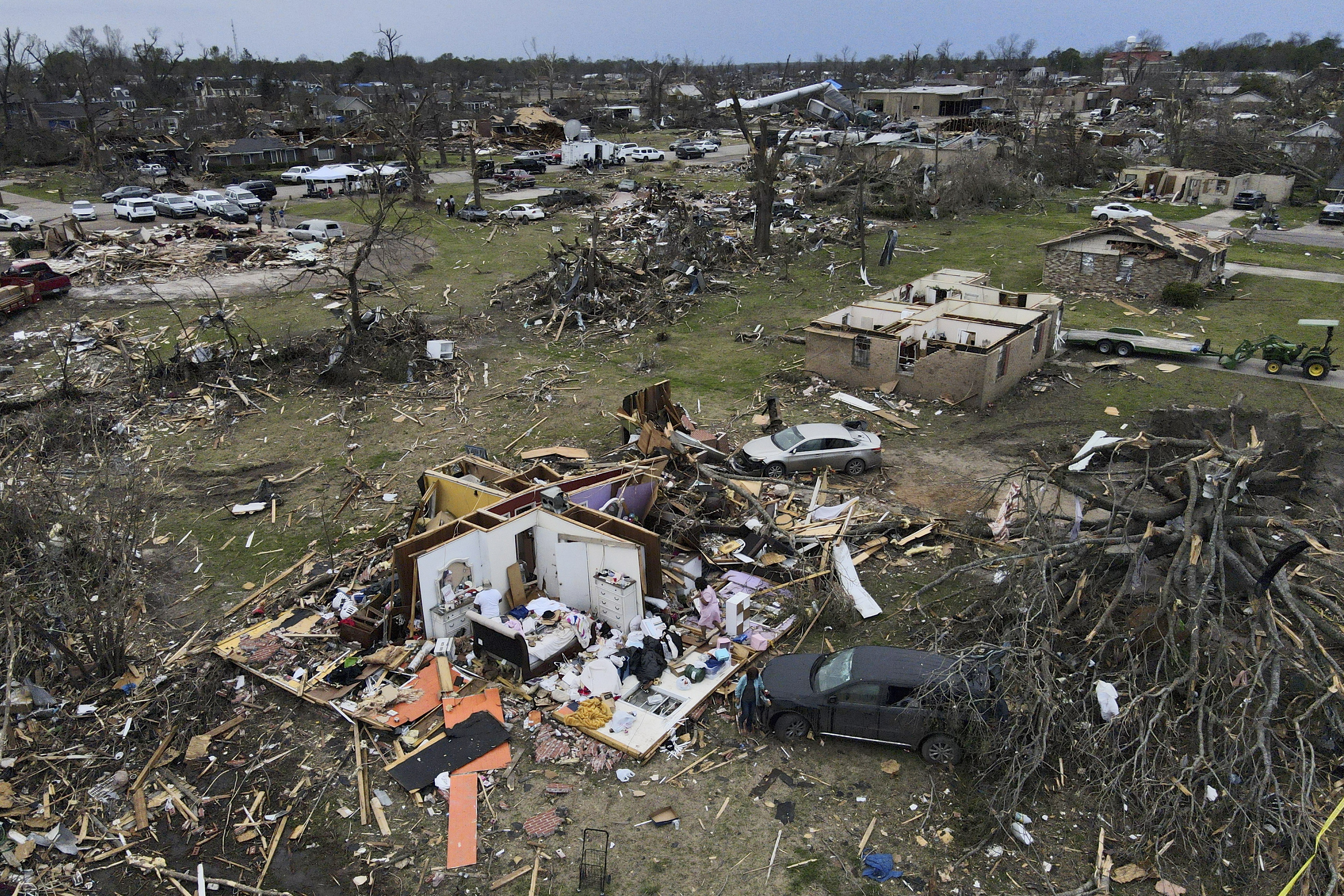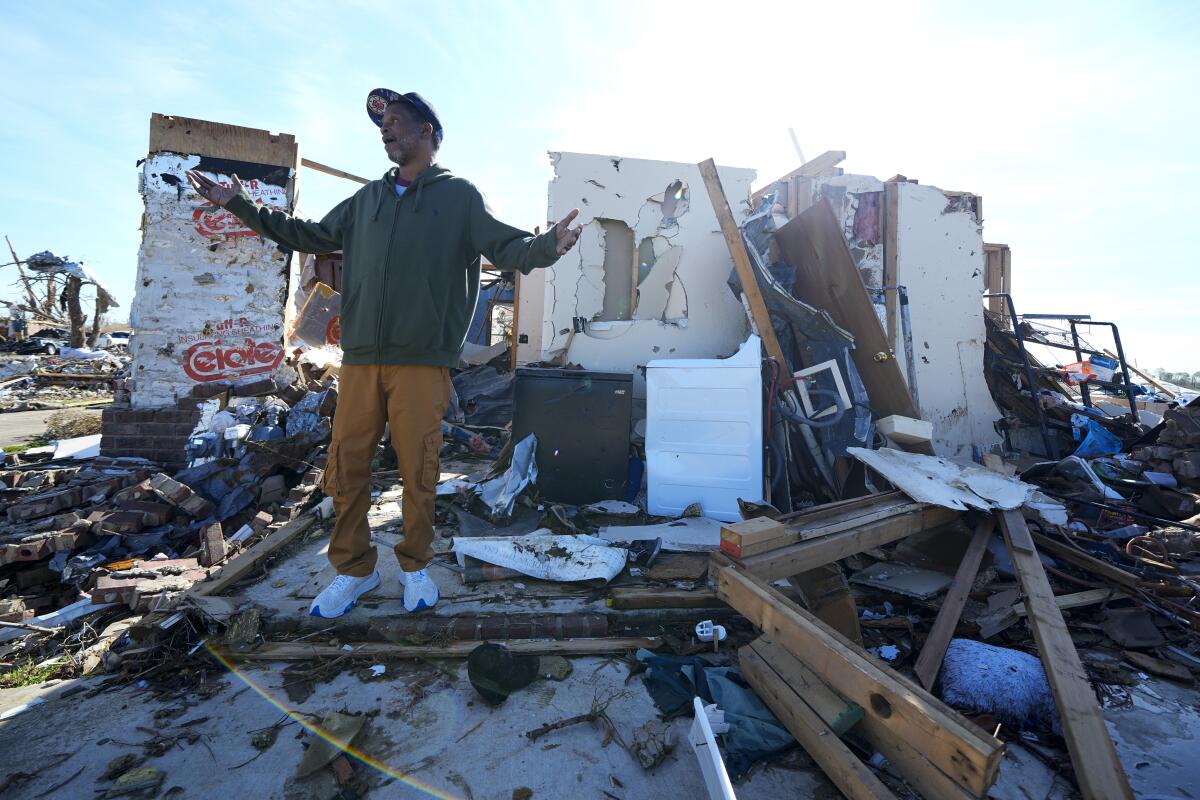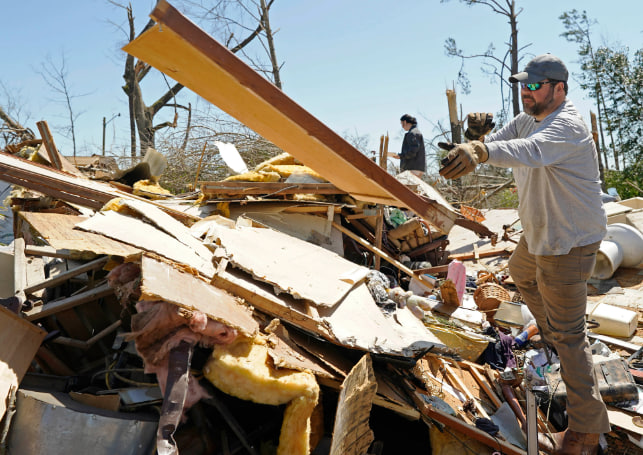Multiple natural disasters have struck the southern United States in a matter of days, overwhelming emergency services and communities already facing widespread destruction. A recent earthquake in Mississippi followed a deadly tornado outbreak and wildfires, compounding the region’s challenges.
Tornadoes Leave Path of Destruction Across the South and Midwest
A powerful series of tornadoes swept through the South and Midwest beginning Friday evening, causing severe damage in several states. According to the Storm Prediction Center (SPC), the outbreak affected multiple regions, with Arkansas, Missouri, Mississippi, Louisiana, and Alabama among the hardest hit.
The SPC had issued a high-level tornado warning days prior, alerting residents to the potential for EF4 or stronger tornadoes. By Saturday, over a dozen tornadoes had been reported, with some communities experiencing multiple tornadoes in under an hour.

Mississippi Among the Most Affected
In Mississippi, Walthall County experienced significant tornado activity, including two intense tornadoes recorded within a 45-minute window. In Tylertown, three fatalities were confirmed, and emergency crews are continuing search-and-rescue efforts.
The National Weather Service (NWS) conducted preliminary damage assessments and confirmed that some tornadoes reached EF3 intensity, with wind speeds estimated up to 165 miles per hour. Officials have indicated that additional surveys may reveal even higher intensities.
Widespread Power Outages and Ongoing Threats
As of Saturday afternoon, over 50,000 customers across Louisiana, Mississippi, and Alabama were without electricity. Downed power lines, fallen trees, and infrastructure damage contributed to the outages. Severe weather threats were forecast to continue into Sunday, affecting an estimated 70 million people from Florida to the Northeast.
Earthquake Strikes Mississippi Amid Storm Aftermath
As recovery efforts from the tornadoes began, residents in Mississippi experienced another natural disaster—a local earthquake. Although details about the magnitude and epicenter are still being verified by the United States Geological Survey (USGS), the event disrupted emergency response operations and heightened anxiety in affected communities.
According to earthquake experts, damage from a seismic event depends on more than just magnitude. Variables such as proximity to the epicenter, soil conditions, and building construction can influence the intensity of ground shaking and potential destruction.
Typically, earthquakes below magnitude 4.0 rarely cause structural damage, but local geological conditions can amplify their effects. Officials continue to assess the impact and determine whether the earthquake caused additional hazards in areas already impacted by tornadoes.

Recent Earthquakes in California Highlight Seismic Risks Nationwide
The earthquake in Mississippi followed a series of small but notable earthquakes in California. According to the USGS, four separate earthquakes occurred near Hayward, California, on Thursday, February 13, 2025. These events ranged in magnitude from 2.7 to 3.6 and were clustered within a small geographic area east of Hayward.
The Hayward Fault, a major fault line in the Bay Area, is known for its seismic activity. Scientists at the University of California, Berkeley Seismology Lab report that the last major quake along this fault occurred in 1868, with an estimated magnitude of 7.0. This quake caused widespread damage and left several dead and injured.
Geologists continue to monitor the Hayward Fault, citing a 27% probability of a magnitude 6.7 or greater earthquake striking the Hayward-Rodgers Creek Fault system within the next 30 years, according to a 2003 working group on California earthquake probabilities.

Oklahoma Wildfires Fuel New Crisis
In addition to tornadoes and earthquakes, wildfires driven by strong winds erupted across Oklahoma on Friday, March 14. The fires have destroyed homes and vehicles and forced widespread evacuations.
Logan County was among the hardest-hit areas, where intense winds and dry conditions allowed fires to spread quickly. KOCO 5 meteorologist Michael Armstrong reported from Highway 105, where structures and cars were engulfed in flames. Emergency officials described the scene as extremely dangerous, with fast-moving fire lines threatening neighborhoods.
Evacuations were ordered in parts of Stillwater after wildfires moved into residential areas. Businesses and hotels, including Holiday Inn Express, Hampton Inn, La Quinta, and a local Walmart, were cleared for safety.
Ongoing Wildfire Containment Efforts
Authorities reported progress on several wildfires, but containment levels varied across counties. In Okmulgee County, the Baldhill wildfire was fully contained, while the Gun Club fire reached 90% containment. Others, such as the Bever and Stripes wildfires, remained partially controlled or had unknown statuses.
In Osage County, wildfires named Acorn, Maker, and Nadel were between 60% and 75% contained. However, officials had not yet determined the containment status for several others, including the Pulare, Tangon, and Bear wildfires.
Multiple counties, including Oklahoma, Garvin, Seminole, Payne, Creek, Murray, and Pontotoc, reported active fires, with emergency teams monitoring changing conditions closely.
Dust Storms Add to Hazards
The National Weather Service in Norman, Oklahoma, reported that intense winds also caused significant dust storms. In northwestern parts of the state, visibility dropped rapidly as dust was pulled into fire zones, complicating firefighting and evacuation efforts.
On Friday night, a fire warning was issued for northeastern Roger Mills County, western Dewey County, and northwestern Custer County. One wildfire located northeast of Leedey was moving east at a slow but dangerous pace, threatening the towns of Camargo, Leedey, and Angora.
Authorities advised residents to prepare for additional evacuation orders, avoid driving through smoke-covered areas, and remain alert for rapidly shifting fire conditions.
Coordinated Emergency Response Underway
Across the South and Midwest, local, state, and federal agencies have mobilized to address the compounded impact of tornadoes, wildfires, and earthquakes. Emergency shelters have been established in affected regions, and utility crews are working to restore power where possible.
In Mississippi and Oklahoma, National Guard units have been deployed to assist with evacuations, deliver supplies, and help manage disaster response logistics. The Federal Emergency Management Agency (FEMA) is also coordinating with state officials to assess damage and expedite federal assistance where needed.

A Nation on Alert
These overlapping disasters serve as a stark reminder of the unpredictable and wide-ranging nature of natural threats across the United States. From earthquakes in California and Mississippi to tornadoes and wildfires in the South and Midwest, communities must remain prepared and informed.
Meteorologists and geologists continue to emphasize the importance of emergency planning, real-time alerts, and infrastructure resilience. As severe weather patterns persist and seismic risks remain, public awareness and preparedness play a crucial role in reducing casualties and accelerating recovery.
Sources:
-
United States Geological Survey (USGS)
-
Storm Prediction Center (SPC)
-
National Weather Service (NWS)
-
KOCO 5 Oklahoma
-
University of California, Berkeley Seismology Lab
-
Federal Emergency Management Agency (FEMA)
